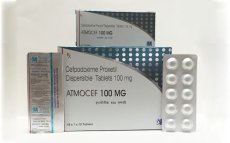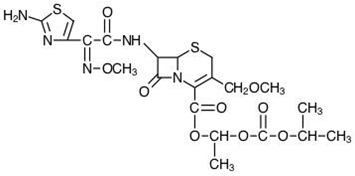
Packing
- 10x10, 10x1x10
(Alu-Alu)
MRP
- 120
Overview
Cefpodoxime is an orally administered, extended spectrum, semi-synthetic antibiotic of the cephalosporin class. It is active in vitro against a wide range of gram-positive and gram negative bacteria. Cefpodoxime is highly stable in the presence of β-lactamase enzymes. As a result, many organisms resistant to penicillin and some cephalosporins, due to the presence of β- lactamases, may be susceptible to Cefpodoxime. The bacterial activity of Cefpodoxime results from its inhibition of cell wall synthesis.
Cefpodoxime is usually active against the following organisms in vitro and in clinical functions: Gram positive Aerobes: Staphylococcus aureus (including penicillinase - producing strains), Staphylococcus saprophyticus, Streptococcus pyogenes, Streptococcus pneumoniae (excluding penicillin- resistant strains) Gram Negative Aerobes: Escherichia coli, Haemophilus influenzae (including β-lactamase producing strains), Klebsiella pneumoniae, Moraxella (Branhamella) catarrhalis, Neisseria gonorrhoeae (including penicillinase - producing strains), Proteus mirabilis. Cefpodoxime is inactive against most strains of Enterococcus, Pseudomonas and Enterobacter.
Indications
- Treatment of patients with mild to moderate infections caused by susceptible strains of the designated microorganisms in the following conditions:
Lower Respiratory Tract Infections: Community acquired pneumonia caused by S. Pneumoniae or H. Influenzae (including β-lactamase−producing strains). Acute bacterial exacerbation of chronic bronchitis caused by S. Pneumoniae, H. Influenzae (non β-lactamase−producing strains only) or M.catarrhalis.
Sexually Transmitted Diseases: Acute, uncomplicated urethral and cervical gonorrhoea, and ano-rectal infections caused by Neisseria gonorrhoea (including penicillinase-producing strains).
Skin and skin Structure: Uncomplicated skin and skin structure infections caused by Staphylococcus aureus (including penicillinase-producing strains) or Streptococcus pyogenes) Urinary Tract Infections: Uncomplicated urinary tract infections (cystitis) caused by Escherichia coli, Klebsiella pneumoniae, Proteus mirabilis or Staphylococcus saprophyticus.
Warnings
Before therapy with Cefpodoxime is instituted, careful inquiry should be made to determine whether patient has previously hypersensitivity reactions to Cefpodoxime, other cephalosporins, penicillin or other drugs.
If Cefpodoxime is to be administered to penicillin sensitive patients, caution should be exercised because cross-hypersensitivity among β-lactam antibiotics has been clearly documented and may occur in up to 10% of patients with a history of penicillin allergy. If an allergic reaction to Cefpodoxime occurs, discontinue use.
Serious acute hypersensitivity reactions may require treatment with epinephrine and other emergency measures, including oxygen, IV fluids, antihistamines, and airway management, as clinically indicated.
Pseudo-membranous colitis has been reported with nearly all antibacterial agents, including Cefpodoxime and may range in severity from mild to life-threatening. Therefore, it is important to consider this diagnosis in patients who present with diarrhea subsequent to administration of antibacterial agents.
Pregnancy & Lactation: Only if needed.
Use in children: Safety and efficacy in infants.
Contraindications
In case of known allergy to Cefpodoxime or to any of the antibiotics in the Cephalosporin group.
Side Effects
Diarrhea
Nausea
Vaginal fungal infections
Abdominal pain
Rash
Headache
Vomiting
Dosage
This is Prefered Dosage:Cefpodoxime Proxetil Tablets should be administered orally with food to enhance absorption.
Disclaimer:To be taken only after consulting with the doctor.
Storage
Store below 25°C, Protected from light & moisture. Keep the medicine out of reach of children.
Pharmacology
Mechanism of Action
Cefpodoxime proxetil is a semi-synthetic beta-lactam antibiotic belonging to the third generation oral cephalosporin group. Cefpodoxime proxetil is the prodrug of the bactericidal antibiotic cefpodoxime. The antibacterial action of cefpodoxime is through inhibition of bacterial cell wall synthesis probably by acylation of membrane bound transpeptidase enzymes; this prevents cross linkage of peptidoglycan chains, which is necessary for bacterial cell wall strength and rigidity.
Pharmacokinetics
Absorption:Cefpodoxime proxetil is absorbed orally and rapidly hydrolysed by non-specific esterases in the gastro-intestinal wall to cefpodoxime, the active acid. Absorption is decreased in conditions of low gastric acidity. With cefpodoxime proxetil tablets the time taken to reach the maximum concentration (Tmax) is about 2-7 hours.Distribution: The drug diffuses well into respiratory tissues. About 27% of cefpodoxime in the plasma is bound to plasma proteins. The volume of distribution is about 0.46 L/kg.
Metabolism: The serum half-life is about 2, 4, 6 hours.
Excretion: Clearance is around 2-4 mL/min/kg. About 81% of unchanged cefpodoxime is excreted in the urine.
Interactions
- Concomitant administration of high doses of antacids (sodium bicarbonate and aluminium hydroxide) or H2- blockers reduces peak plasma levels by 24-42 % and the extent of absorption by 27-32%, respectively.
- As with other β-lactam antibiotics, renal excretion of Cefpodoxime was inhibited by probenecid, and resulted in an approximately 31% increase in AUC and 20% increase in peak Cefpodoxime plasma levels.
For Patients
- Take this medicine by mouth with a full glass of water. Take with food.
- Take your medicine at regular intervals. Do not take more often than directed.
- Take all of your medicine as directed even if you think you are better. Do not skip doses or stop your medicine early.
- Talk to your pediatrician regarding use of this medicine in children. Special care may be needed.
- Over-dosage: In the event of serious toxic reaction from over-dosage, haemodialysis or peritoneal dialysis may aid in the removal of Cefpodoxime from the body, particularly if renal function is compromised.
Chemistry
Cefpodoxime Proxetil is an orally administered, extended spectrum, semi-synthetic antibiotic of the cephalosporin class. The chemical name is (RS)-1(isopropoxycarbonyloxy) ethyl (+)-(6R, 7R)-7-[2-(2-amino-4-thiazolyl)-2-{(Z)methoxyimino} acetamido]-3-methoxymethyl-8-oxo-5-thia-1-azabicyclo [4.2.0]oct-2-ene-2-carboxylate.
Its empirical formula is C21H27N5O9S2 and its structural formula is represented below:
